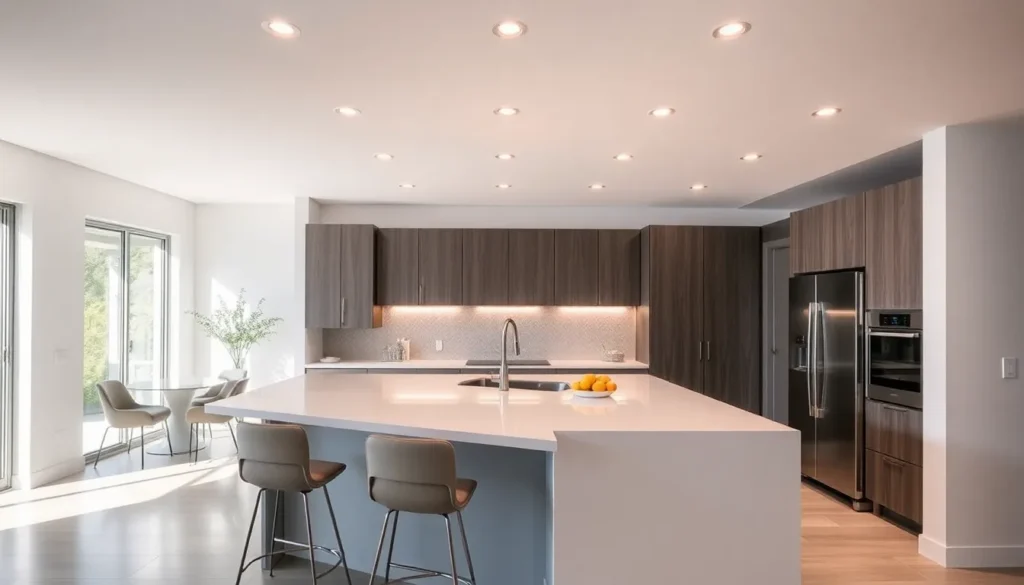Recessed lighting can transform a dull room into a dazzling space, but getting the placement just right is no walk in the park. Think of it this way: no one wants their lights to resemble that awkward first date, too close and overwhelming, or too far and forgettable. With the right guidance, but, you can master the art of recessed lighting placement like a professional, turning your home into a beautifully illuminated haven. So, let’s jump into the world of recessed lighting and shed some light on the details.
Table of Contents
ToggleUnderstanding Recessed Lighting

Recessed lighting, often known as can lights or pot lights, is a type of lighting fixture that is installed into a hollow opening in the ceiling. This sleek and stylish option offers a modern touch to any room while providing a clean look. When positioned properly, recessed lights blend seamlessly into the ceiling, providing ambient lighting that doesn’t take center stage. They come in various sizes, colors, and styles, allowing for versatility in design and functionality.
Most commonly used in residential settings, recessed lighting has become a favorite choice for homeowners and designers alike due to its ability to create a warm, inviting atmosphere without overpowering the decor.
Benefits of Recessed Lighting
First and foremost, recessed lighting maximizes space. Unlike hanging fixtures that may crowd a room, recessed lights allow for a more open feeling. This can be especially beneficial in smaller areas where every inch counts.
Another fantastic perk is the ability to highlight specific elements in a room. Whether it’s a stunning piece of artwork on the wall or a unique architectural feature, strategically placed recessed lights can pull focus and add visual interest.
Also, these lights can be used to create various lighting effects. From accent lighting that draws attention to specific areas to ambient lighting that casts a soft glow, recessed lighting is incredibly versatile. Also, many recessed lights come with dimmers, allowing homeowners to adjust the brightness according to their mood, time of day, or occasion.
Factors to Consider for Placement
When considering recessed lighting placement, several factors come into play. It’s crucial to think about the room’s purpose. Will the area serve as a workspace, entertainment zone, or simply a gathering place? Each scenario demands different lighting requirements.
Optimal Placement Techniques
One key technique is maintaining proper spacing between fixtures. A common rule of thumb is to place the lights about 4-6 feet apart for even illumination, but this can vary based on the height of the ceiling and the type of space. For example, higher ceilings may require closer spacing to prevent dark spots.
Another critical element to consider is the position of the lights relative to objects, walls, and furniture. Aiming for highlights rather than glare can greatly enhance a room’s aesthetic. It’s generally recommended to position fixtures about 18-24 inches away from walls to ensure proper light distribution without casting unwanted shadows.
Room-Specific Placement Guidelines
Placement can vary significantly depending on the room. Here’s a breakdown to consider for different areas in your home:
Living Room
In the living room, recessed lighting can create a warm atmosphere perfect for gatherings or quiet evenings. Arrange the lights around the perimeter for general lighting, while including a few directed towards conversation areas or media features for those cozy movie nights.
Kitchen
For kitchens, recessed lights should be slightly brighter since this is often a workspace. Strategically place fixtures over food preparation areas, cooking zones, and kitchen islands to ensure adequate lighting. Pendant lights are also a great addition here to bring a stylistic touch while augmenting the lighting further.
Bathroom
In bathrooms, recessed lights should be positioned around the vanity area for clear reflection while avoiding harsh shadows. A good rule of thumb is to install them about 30-36 inches above the countertop to ensure consistent illumination during grooming activities.
Bedroom
In bedrooms, use recessed lights to create a calming environment. Placing them on dimmers allows for an atmospheric glow during bedtime. Positioning them over reading areas or along the bed can enhance the cozy feel without overwhelming the space.
Tips for Effective Installation
When it comes to installing recessed lighting, always prioritize safety. Opt for lights that are rated for insulation contact if they’ll be placed near insulation for fire safety. Hiring a licensed electrician is highly recommended unless one has substantial electrical knowledge.
Besides, consider using a template to mark the placement of the fixtures. This makes the process smoother and adjustments easier before committing to cutting. Make sure to account for ceiling joists, which may interfere with the placement of lights.
Finally, don’t overlook the importance of selecting the right color temperature for your recessed lighting. Generally, a soft white (2700K) is perfect for cozy spaces while cooler whites (3500K-4000K) work better in work areas like kitchens.

